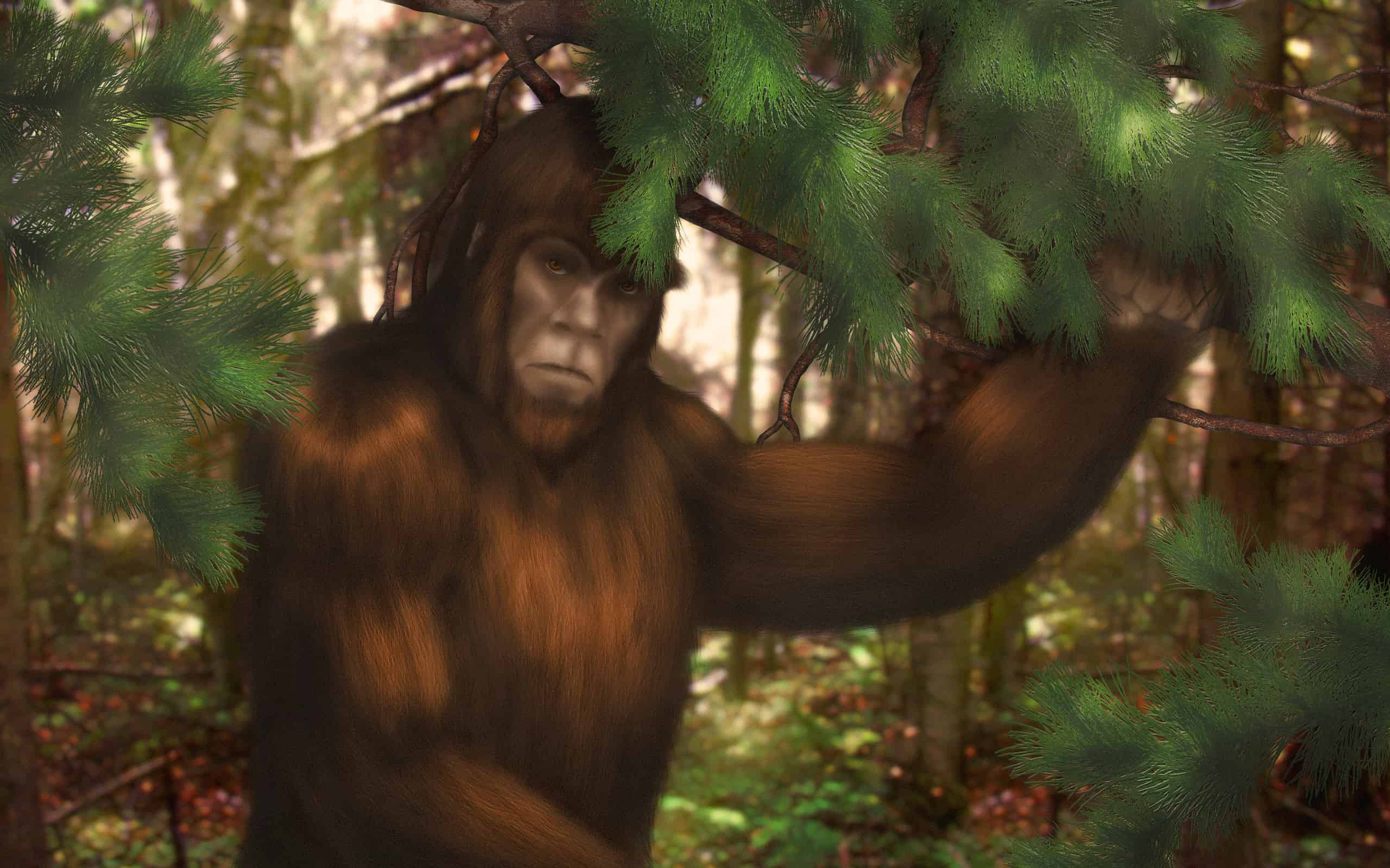Sasquatch. Yeti. Do both names bring similar pictures of massive apelike hominids to mind? Maybe, but that doesn’t mean that there aren’t fundamental distinctions between the two. Both are cryptids, animals that a group of people believe to exist but that they don’t have scientific evidence to back them up.
Sasquatch has become the generally accepted name for the wild primate-human hybrid that hikers and hunters have often spotted in North America. Some call the creature “Bigfoot” — a term which may have begun in 1958. That’s when Gerald Crew of Bluff Creek, CA, made a cast of the immense footprints left by an unknown creature near his bulldozer.
The term Sasquatch, though, originated much earlier. The Sts’ailes people of the Fraser Valley — in the Pacific Northwest and parts of Vancouver Island in British Columbia — called them Sésquac or Sasq’ets. The Halq’emeylem dialect of the word meant “wild man.” Europeans later anglicized it to Sasquatch, which is the more common term for this cryptid.
The Yeti, on the other hand, is a large apelike hominid found in areas across the Himalayan Mountains throughout India, Bhutan, and Nepal, as well as in Russia and China. This humongous creature lives in the area’s harsh climates and is the subject of local legends predating Buddhist civilizations.
In 1921, Henry Newman, a reporter for a paper called The Statesman, coined the term “Abominable Snowman” after interviewing members of the British Mount Everest Reconnaissance Expedition. These men had come across gigantic footprints in the snow while ascending the mountain.
The guides leading these men explained that the “Metoh-Kangmi” had left the footprints. The word “kangmi” meant “snowman,” while “metoh” meant” “man-bear.” Newman incorrectly translated the word to “filthy snowman,” which he changed to “abominable snowman” afterward. Today, Yeti is the generally accepted word for this creature, however.
The Sasquatch and the Yeti are both sources of speculation with some groups, but both also invite devout belief from other groups. Let’s take a look at the Sasquatch vs. Yeti and the five key differences between these two hominids.
Origins

Many Sherpas, Mount Everest climbers and explorers, and Himalayan guides have stories about encountering the Yeti.
©Martin M303/Shutterstock.com
The Sasquatch is indigenous to North America, particularly the Pacific Northwest. The Sts’ailes people called this creature Sasq’ets, which meant “hairy man” or “wild man” in the Halq’emeylem dialect. The first documented tale of the Sasquatch came from an 1865 report by ethnographer George Gibbs.
Yeti is a Himalayan hominid whose stories have been told in the Asian countries of Bhutan, India, Nepal, China, and Russia — predominantly in the Himalayas. Stories of the Yeti go back to the time before Buddhism. However, one of the first documented accounts is from 1921, when Charles Howard-Bury, a British explorer, discovered huge footprints near the Lakhpa La Pass in the Himalayas.
Size

Both the Sasquatch and the Yeti are towering and muscular bi-pedal humanids, but there are key differences.
©JM-MEDIA/Shutterstock.com
While both cryptids are massive and muscularly built, descriptions of the Sasquatch depict it as being 7 to 15 feet in height with a powerfully muscular build. The Yeti, on the other hand, is described as 6 to 10 feet in height and weighing 200 to 400 pounds.
Both the Yeti and Sasquatch have left footprints in their wakes. The Sasquatch’s footprints — found in parts of British Columbia, Canada, and parts of the United States — were as long as 2 feet and as wide as 8 inches. Some of them had claw marks, while others were more human.
Habitat

The Yeti’s home is primarily in the harsh environment of the Himalayas.
©Warpaint/Shutterstock.com
The Sasquatch is a forest dweller. It lives primarily in the Pacific Northwest of North America. British Columbia, in particular, is a hotspot for Sasquatch sightings. Since 1900, the town of Harrison Hot Springs in British Columbia has had 37 noteworthy recorded sightings alone.
There are other places in the U.S. in which people have reported seeing Sasquatch. These include Northern California, Provo Canyon in Utah, the Allegheny National Forest in Pennsylvania, Washington’s Blue Mountain, and northern Michigan.
The Yeti is a South Asian native. It has been spotted in Nepal, on Mt. Everest, in Northern India, and in Tibet. There have also been sightings in Russia, Bhutan, and China. One early Everest climber even spotted the hominid at 21,000 feet up the mountain.
The Barun Valley in the Himalayas is a spot where some people believe the Yeti lives. It’s a very dense jungle ecosystem with an abundance of rainfall, and it’s virtually uninhabited by humans. This wild and rugged area would seem to be an ideal habitat for the mysterious and elusive Yeti.
Descriptions

Though descriptions of both the Sasquatch and Yeti have varied over the years, there are fundamental characteristics that have remained constant.
©Елена Бабенкова/iStock via Getty Images
Sasquatch is a gargantuan, bi-pedal, apelike hominid. Some descriptions allege that it’s 7 to 10 feet tall, while others claim it’s almost 15 feet tall. Its muscular body is covered in black, brown, or dark reddish hair from head to foot. Many people have characterized its face as humanlike and claim that the creature is overall more human than apelike.
Most reported sightings detail the Sasquatch as having broad shoulders, disproportionately long arms, no neck, and glowing yellow or red eyes (if seen at night). Several people who have spotted the elusive cryptid have reported smelling an intensely foul odor associated with it.
The Yeti is described as a lean and muscular creature with white, gray, or brown shaggy hair. Not as tall as the Sasquatch, observers describe it as being 6 to 10 feet tall and weighing 200 to 400 pounds. Unlike the Sasquatch, Yetis — in Tibetan lore — have three varieties. The Nyalmo is the largest and ferocious with black fur, the Chuti is the medium-sized variety, and the Rang Shim Bombo is only three to five feet tall with reddish-brown hair.
Some people who claim to have seen the Yeti describe it as having sharp teeth. Like the Sasquatch, it is bipedal and apelike. However, whereas its cryptid cousin is more humanlike, the Yeti is more animal-like. Pliny the Elder — all the way back in 326 BC — wrote that the creature is extremely swift and can only be caught if they are old or sick.
Behavior

People who have reported interacting with either the Yeti or Sasquatch have unfortunately not introduced video or photo evidence to support their claims.
©iStock.com/Warpaintcobra
Over the last several centuries, many thousands of eyewitnesses have seen the Sasquatch at a distance. Some have even had close encounters with them. Additionally, many campers claim to have been approached at night or even followed in a parallel fashion by one of them along a hiking trail. However, of all the thousands of reports, only two describe people being attacked by Sasquatch. One of the attacks was described by Theodore Roosevelt.
While the Sasquatch doesn’t seem to bother humans if not provoked, there have been reports of this creature killing or brutally injuring aggressive dogs who have pursued it. People have also claimed that it has raided their rabbit hutches, chicken coops, or fruit orchards.
The Yeti is depicted as more aggressive than the Sasquatch. They have reportedly attacked people, killed and eaten yaks — often killing the huge domesticated beasts in one swipe — and have supposedly even eaten people. However, since there seem to be three different varieties of the Yeti, there are also different descriptions of its behavior.
Some people claim that the Yeti is a peaceful and shy creature. Numerous monks in the Himalayas even consider it to be sacred. Other people claim that the creature terrorizes and stalks humans. In Sherpa folklore, the Yeti is a symbol of danger.
Summary of Differences Between Sasquatch and Yeti
| Number | Characteristic | Differences |
|---|---|---|
| 1. | Origin | Sasquatch — Pacific Northwest Sts’ailes people Yeti — Himalayan peoples dating back to 326 B.C. |
| 2. | Size | Sasquatch — 7 to 15 feet tall Yeti — 6 to 10 feet, 200 to 400 pounds |
| 3. | Habitat | Sasquatch — Mainly in the Pacific Northwest region of the U.S. and British Columbia, Canada Yeti — Himalayan mountain regions in Southern Asian countries |
| 4. | Descriptions | Sasquatch — more humanlike, black, brown, and dark reddish fur, powerfully built Yeti — more apelike, white, gray, or brown fur, lean muscular build |
| 5. | Behaviors | Sasquatch — elusive, inquisitive, not typically aggressive unless provoked Yeti — some varieties are aggressive and fierce, others are peaceful and shy |
The photo featured at the top of this post is © Raggedstone/Shutterstock.com
Thank you for reading! Have some feedback for us? Contact the AZ Animals editorial team.







